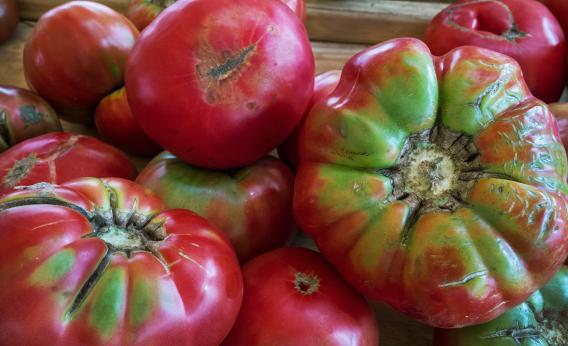Following up on a series of tongue-in-cheek yet educational books by contributing editor David Kamp, Vanity Fair began releasing short video entries from “The Snob’s Dictionary” earlier this summer. After putting out an episode on American International Pictures for film snobs and one on Nick Drake for rock snobs, the magazine has finally produced a video for food snobs. The subject? Heirloom tomatoes.
In spite of its snarky tone and cheesy double entendres, the video is fairly informative, offering a decent definition of heirloom tomatoes: “irregularly shaped, vividly colored fruits grown from the seeds of non-hybridized tomato plants, thereby standing apart from the drab supermarket tomatoes, which are uniformly orange and spheroid.” Unlike the plants favored in industrialized agriculture, which are cross-bred for traits like hardiness and visual appeal, heirloom breeds are varieties that were pollinated without human meddling and that have reproduced for decades or centuries. Heirloom tomatoes often look weirder than conventional tomatoes, and they tend to be way more fragile, but many heirloom varieties have a superior flavor and texture. Plus, the genetic diversity of heirloom plants acts as insurance against blights that could hypothetically wipe out genetically homogeneous crops to devastating effect.
But as the very existence of a “Snob’s Dictionary” entry on heirloom tomatoes implies, such plants project a certain rarefied image. As the Vanity Fair video puts it, their perpetuation “has been helped along recently by beardy young neo-rustics who are only too happy to try their hand at cultivating antique produce.” Interest in heirloom varieties among the modish set is undeniable, but heirloom varieties aren’t really much like antiques—their value is in their genetics and their fertility, not their age, appearance, or collectability. Yet the very name “heirloom” perpetuates the idea that these old, non-hybridized cultivars are just kept around by rich people for their cachet.
Heirloom vegetables need a brand makeover. The food movement has enough of a class problem already; it doesn’t need misleading monikers making it look even more elitist. “Heritage vegetables,” as they’re sometimes called in other English-speaking countries, is a little bit better than “heirloom vegetables,” but “heritage” still gives off a whiff of aristocratic privilege. A much better label, in my opinion, would be “traditional vegetables,” which gives some sense of the definition of these plants without any caste connotations.
Or, better still, since it’s hard to convey the meaning and importance of so-called heirloom vegetables in a single word, why not get rid of the umbrella term altogether and let each individual variety speak for itself? One great thing about non-hybridized vegetables is that there are so many kinds of them with so many different traits and histories. Consider the Blaby Special tomato, an English wartime favorite that was thought to have died out until a scientist tracked down its seeds in 2006, or the Cream Saskatchewan watermelon, a Russian variety with ghostly white flesh. Lumping thousands of traditional vegetable varieties together in a single category—for the sake of distinguishing them from standardized conventional crops—is a tad ironic.
Can you think of a better name for heirloom vegetables? Let us know in the comments.
